Customer Journey Mapping: Stages, Templates & Examples
Customer journey mapping visualizes the customer's experience with a company. It helps to identify pain points or opportunities for improvement to enhance overall satisfaction and engagement.
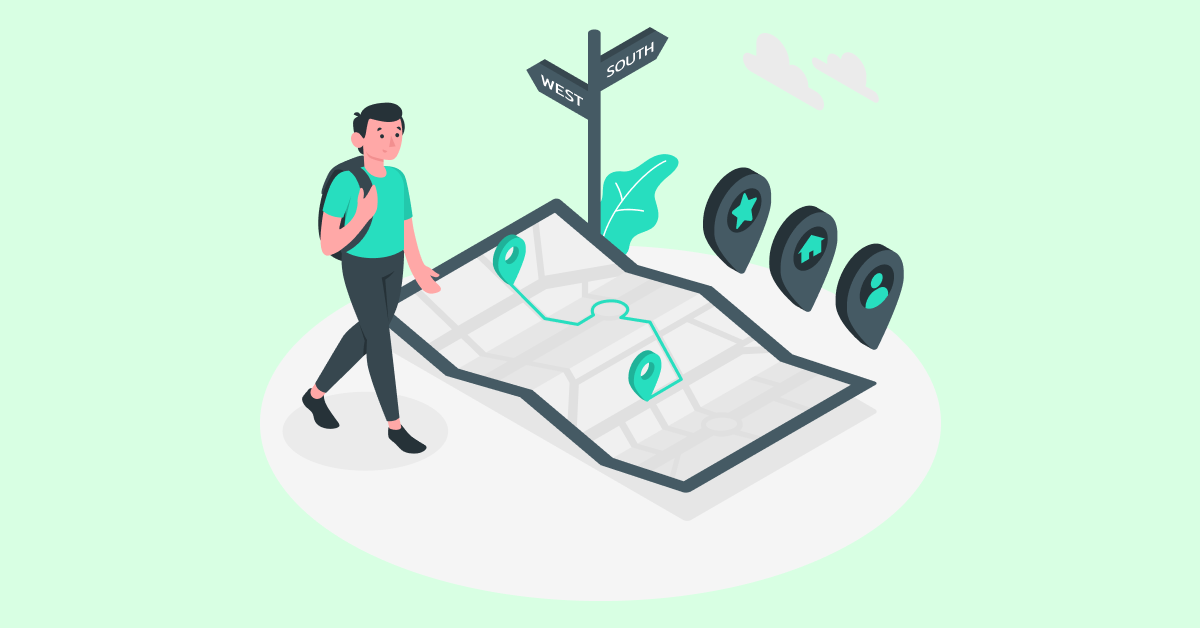
Customer journey mapping visualizes the customer's experience with a company. It helps to identify pain points or opportunities for improvement to enhance overall satisfaction and engagement.

Ever wondered what goes on behind the scenes when a customer interacts with a brand? How do they move from being a potential lead to a loyal customer? Customer journey mapping helps businesses understand and improve the customer experience by visualizing every step of the customer’s interaction.
Customer journey maps have become a crucial tool for businesses looking to enhance customer satisfaction and loyalty. Analyzing every touchpoint along the customer’s journey allows companies to identify pain points and ways to enhance the overall experience. Companies that use tools like customer journey maps see revenues increase as much as 10 to 15 percent while also reducing their cost of service by 15-20%.
Understanding the customer journey map is essential for success. Mapping out the customer experience allows businesses to gain valuable insights that can drive strategic decision-making. It leads to increased customer satisfaction and retention. Here we will explore the concept and discuss how businesses can use it to create a seamless customer experience.
A customer journey map refers to the visual representation of the steps and interactions a customer goes through when engaging with a product or service. It outlines a customer’s various experiences from the initial awareness stage, through the purchasing process and post-purchase follow-up. Analyzing the customer journey allows businesses to gain insights into customer behavior and preferences. It allows them to improve their overall customer experience and increase customer satisfaction.
Key use cases:
if you want to take your customer relationships to the next level and outshine your competitors, it’s time to delve deeper into the key advantages that the strategic approach can offer your business.
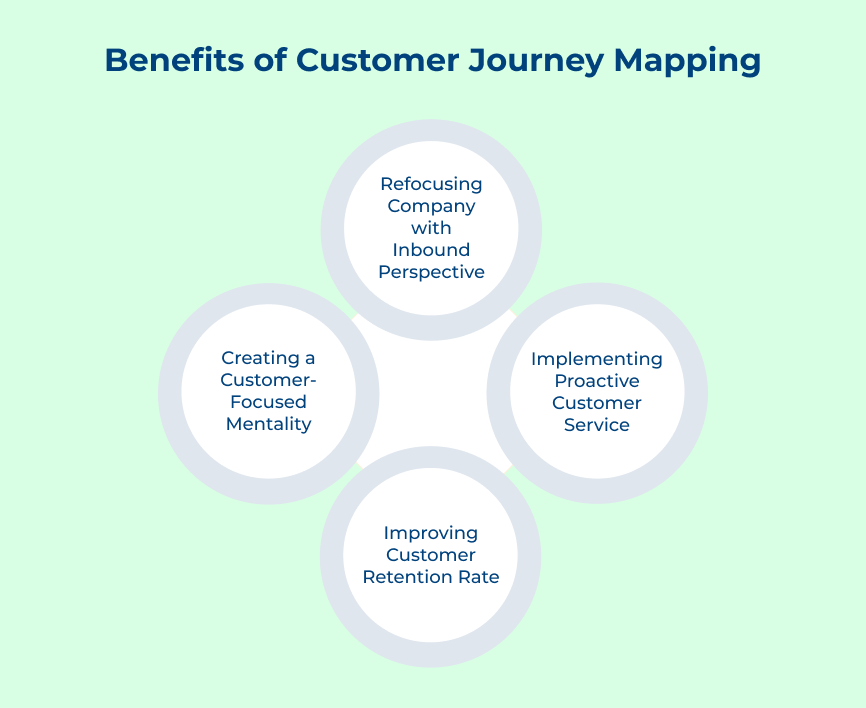
Mapping out the customer journey allows the brand to identify touchpoints where It can engage customers in a more personalized and relevant way. The inbound approach can help the brand to attract and retain customers more effectively.
Customer journey mapping can help the brand anticipate customer needs and pain points along their journey. The knowledge allows the brand to proactively address issues and provide solutions before customers even realize they have a problem. Leading to higher satisfaction and loyalty.
Identifying areas of friction in the customer journey allows the brand to make improvements to enhance the overall customer experience. It can lead to higher satisfaction levels and ultimately increase customer loyalty or retention rates.
Customer journey mapping allows the brand to establish a customer-centric culture within the organization. Involving employees from different departments allows the brand to ensure that everyone understands the importance of putting the customer at the center.
Mastering the customer journey stages is essential to truly connect with your target audience and drive conversions. Let’s explore the key stages of the customer journey to enhance your business strategy for sustainable growth and success.
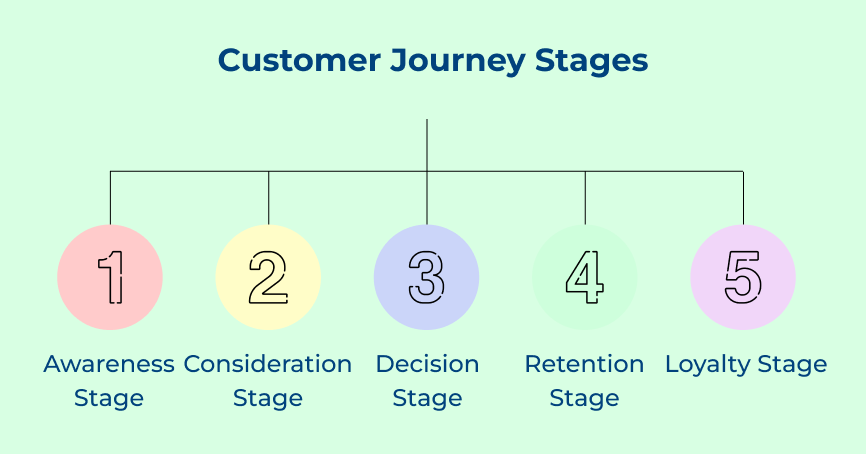
The awareness stage is the first stage of the customer journey where the customer becomes aware of a particular product or service. It is typically the stage where customers identify a problem or need that they have and begin to search for solutions. The goal at this stage is to create awareness of the brand and establish a presence in the minds of potential customers.
Once a customer is aware of the brand, they move on to the consideration stage where they start to evaluate different options available to them. It is the stage where customers conduct research, compare different products and weigh the pros or cons of each option. It’s important to provide valuable information and engage with customers to help them make an informed decision.
Customers are ready to make a purchase and choose a specific product or service. It is the stage where the marketing efforts can make a significant impact. Providing incentives, discounts or promotions to encourage customers to choose the brand over competitors. It’s important to make the purchasing process as seamless and convenient as possible to ensure a smooth transition from consideration to action.
The retention stage is often overlooked by marketers, but it’s a crucial stage in the customer journey. Once a customer has made a purchase, it’s important to focus on retaining their loyalty and encouraging repeat purchases. It can be done through personalized communication, loyalty programs and exceptional customer service. Building strong relationships with customers at this stage can lead to long-term loyalty and advocacy.
The final stage of the customer journey is the loyalty stage. Here customers have developed a strong bond with the brand and become advocates for the products or services. Loyalty is built on trust, consistent quality and exceptional customer experiences. Continuing to engage with loyal customers and rewarding their loyalty allows the brand to create brand advocates who drive word-of-mouth marketing.
Let’s delve into what exactly is involved in the customer journey mapping process and how it can benefit your business.
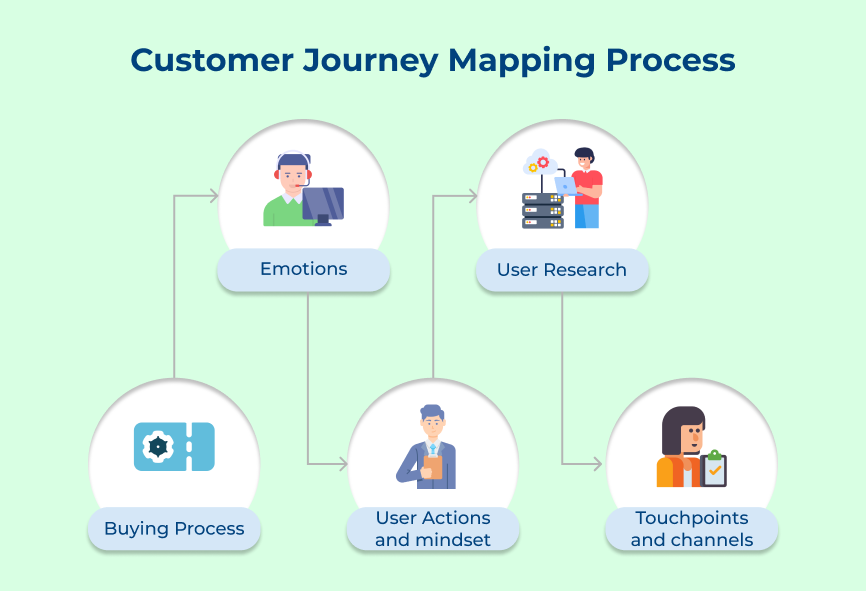
“The Buying Process” is one of the key elements of the customer journey map process. It involves mapping out the steps that a customer goes through from the initial awareness of a product or service to the final purchase. The element is crucial in understanding the customer’s behavior, preferences and decision-making process.
Analyzing the buying process helps businesses identify opportunities for improvement, optimize marketing strategies and ultimately increase sales. It allows them to pinpoint where customers may be dropping off or experiencing barriers in the purchasing journey. It helps to make necessary adjustments to streamline the process.
When analyzing the buying process, data points to consider include:
Emotions play a crucial role in the customer journey mapping process, as they are key elements that can make or break a customer’s experience with a brand. Understanding customer emotions can provide valuable insights into their motivations, preferences and behaviors throughout their interaction with a product or service.
Customer emotions are an important element in the customer journey map. They can help businesses identify pain points and areas where they can create an impactful experience for their customers. Tracking emotions at different touchpoints in the customer journey allows businesses to tailor their marketing strategies, product offerings and customer service efforts. .
Customer sentiment can be measured using data from:
User actions refer to the specific steps that customers take when interacting with a business such as browsing a website or contacting customer support. Understanding these actions helps businesses identify pain points in the customer journey and develop solutions to improve the overall experience.
The mindset of the user is equally important, as it provides insight into the emotions, motivations and preferences that drive their actions. Understanding the mindset of the customer allows businesses to create personalized marketing campaigns. It helps to tailor their products and services to meet the needs of their target audience.
Businesses can collect data from various sources such as:
User research is a key element of the customer journey map process, providing valuable insights into the behaviors, needs and motivations of customers. The element involves gathering data through various methods such as surveys and observation to understand the customer experience from their perspective.
User research is crucial in the process as it helps businesses identify pain points, opportunities and moments of delight for their customers. Understanding the customer journey through research allows businesses to tailor their products, services and communication strategies. It helps to better meet the needs and expectations of their target audience.
Touchpoints and channels are key elements of the process. These elements provide an overview of all the interactions a customer has with a brand, from initial awareness to post-purchase engagement. Customer journey map process involves identifying touchpoints and channels is crucial for understanding how customers engage with the brand at different stages.
Businesses can optimize their marketing strategies and create a seamless customer experience. Touchpoints and channels are part of the exploration stage in the customer journey. Where customers are first introduced to the brand and start their research process.
Businesses must gather and analyze various types of data to effectively map out the customer journey. The two key types of data that are necessary for consumer journey mapping are solicited data and unsolicited data.
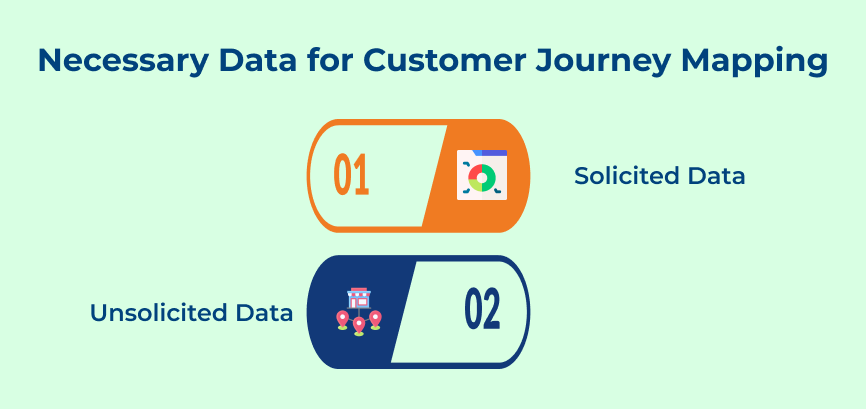
Solicited data refers to information that is willingly provided by customers. It can include data such as survey responses, feedback forms, online reviews and customer preferences. Solicited data is valuable for understanding customer preferences, interests and needs. Solicited data can help businesses identify key touchpoints in the customer journey and tailor products or services to meet customer needs.
Types of data available under solicited data include:
Unsolicited data refers to information that is gathered without the explicit consent of customers. It can include data such as website analytics, social media mentions and customer behavior tracking. Unsolicited data can help businesses identify pain points in the customer journey, track customers and optimize customer touchpoints for a seamless experience.
Types of data available under unsolicited data include:
Creating a customer journey map involves analyzing every touchpoint a customer has with your brand. Let’s delve into the essential steps to effectively create a customer journey map that will drive success for your business.
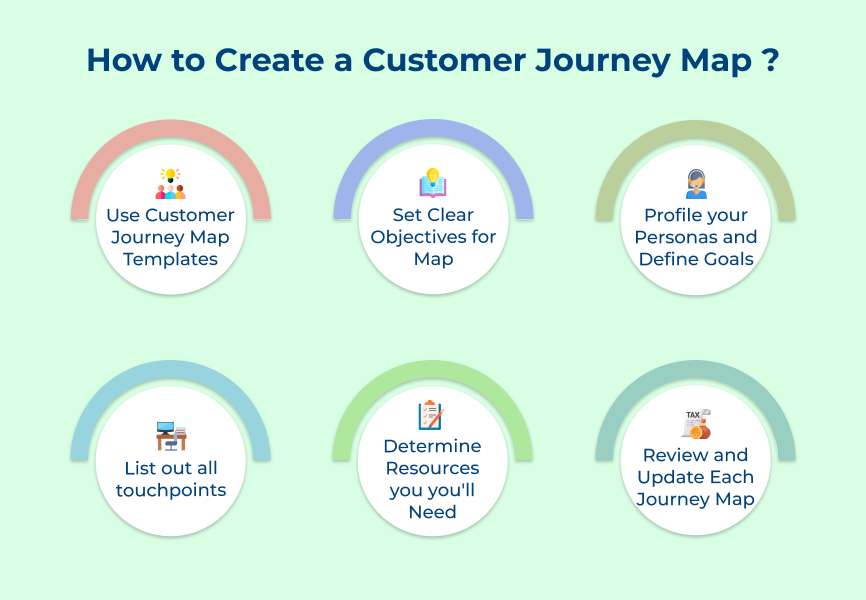
Customer journey map templates are essential tools in creating a visual representation of the customer experience across various touchpoints. These templates provide a guide for businesses to understand their customer’s interactions, emotions and needs throughout their journey.
The first step in creating the journey map is to choose an appropriate template that fits the business needs. An ideal consumer journey map template should include key touchpoints, customer emotions, pain points and opportunities for engagement. One use case for using templates is to improve the overall customer experience by identifying areas for improvement and enhancing customer satisfaction.
Pro tips:
When creating a customer journey map, setting clear objectives for the map is a crucial step. The step involves clearly defining what the brand aim to achieve with the consumer journey map. It may include improving customer satisfaction, increasing sales or identifying pain points in the customer experience.
Setting clear objectives helps to guide the creation process of the map. It ensures that the map is focused to the goals of the business, allowing for more effective decision-making and prioritization of actions. Let’s take an example of a company that wants to improve customer retention. The objective of the consumer journey map could be to identify key touchpoints where customers are most likely to churn.
Pro tips:
One of the crucial steps involves profiling the brand personas and defining their goals. The step is essential as it helps the brand to understand the different types of customers it has and what their needs or motivations are. Creating detailed personas and defining their goals allows the business to tailor its marketing strategies to better meet the needs of its target audience.
Let’s take an example of a person who runs a beauty salon. He has identified two key personas – busy working professionals and stay-at-home parents. Profiling these personas and understanding their goals allows the brand to create customized marketing messages or offers that cater to their specific needs.
Pro tips:
Creating a customer journey map is essential for businesses to understand their customer’s experience and improve their overall satisfaction. One crucial step in creating a consumer journey map is listing out all touchpoints that customers interact with throughout their journey with the company.
Let’s take an example of a retail store that may list out touchpoints such as its website, physical store locations, email newsletters and social media platforms. Analyzing customer interactions at each touchpoint allows the store to create a customer journey map. It highlights areas where they can enhance the overall customer experience.
Pro tips:
When creating a consumer journey map, it is essential to determine the resources the brand has and the ones the brand needs to execute consumer journey map. The step involves taking inventory of the current resources and identifying what additional resources may be required to create a successful customer journey map.
Let’s take an example of a brand that has access to customer data but lacks the necessary software to analyze it effectively. The brand can identify the need to invest in data analytics tools. It will enable the brand to gather and analyze customer information more efficiently, resulting in a more insightful customer journey map.
Pro tips:
Creating a consumer journey map is an essential step in understanding the customer experience and improving overall satisfaction. One key aspect of creating an effective customer journey map is to review and update it after every major product release. It ensures that the map accurately reflects the current state of the customer’s interactions with the brand.
Reviewing and updating the journey map after every major product release allows the brand to track how the changes have impacted the customer experience. It allows the brand to identify any pain points or areas of improvement and adjust its strategies accordingly. Let’s take an example of a brand that releases a new feature that customers are struggling to understand or use. Updating the journey map will help pinpoint where the issue lies and how to address it effectively.
Pro tips:
Businesses must ensure they have the right tools at their disposal to effectively create and analyze customer journey maps. Let’s explore the top five tools to help you with journey mapping.
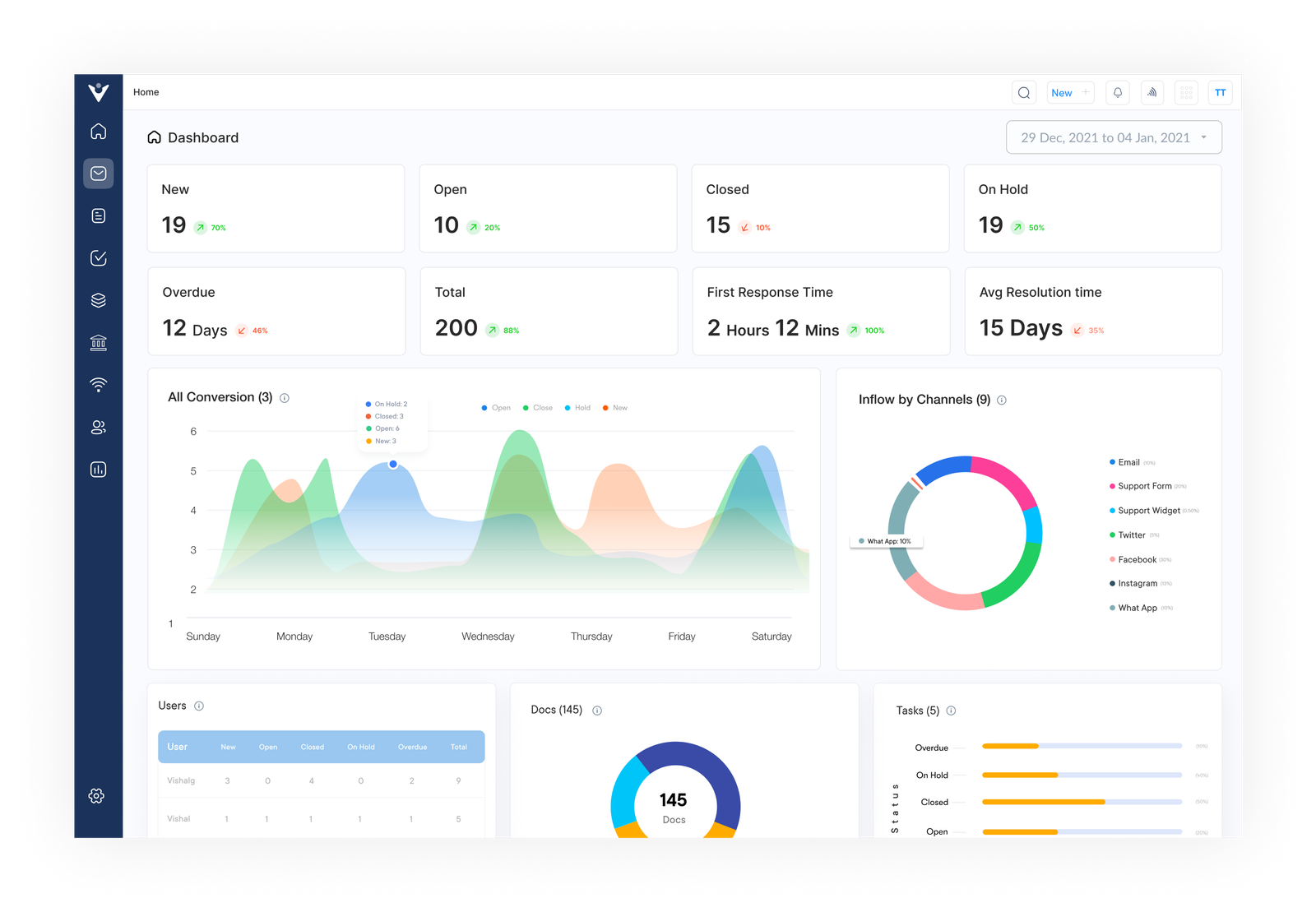
Veemo is a digital tool designed to simplify and streamline the process of creating customer journey maps for businesses of all sizes. It provides an intuitive platform for teams to collaborate on visualizing and analyzing the entire customer experience across various touchpoints. Veemo helps organizations gain deeper insights into their customers’ interactions, emotions and pain points throughout their relationship with the brand.
Five key features of Veemo:
Canvanizer is a digital tool that allows users to create and collaborate on journey maps. The platform provides a user-friendly interface with customizable templates for creating customer journey maps. Users can add touchpoints, interactions and emotions to each stage of the customer journey, making it easy to visualize the entire experience. Canvanizer also allows for real-time collaboration, making it a great tool for teams working on journey-mapping projects together.
UXPressia is another powerful tool for creating customer journey maps. The platform offers a variety of pre-designed templates and elements to help users map out the customer experience. Users can add personas, touchpoints and channels to create a comprehensive journey map. UXPressia also provides analytics and reporting features, allowing businesses to track the success of their customer journey initiatives.
Let’s explore the key strategies to improve your customer journey mapping and create an experience that keeps your customers coming back for more.
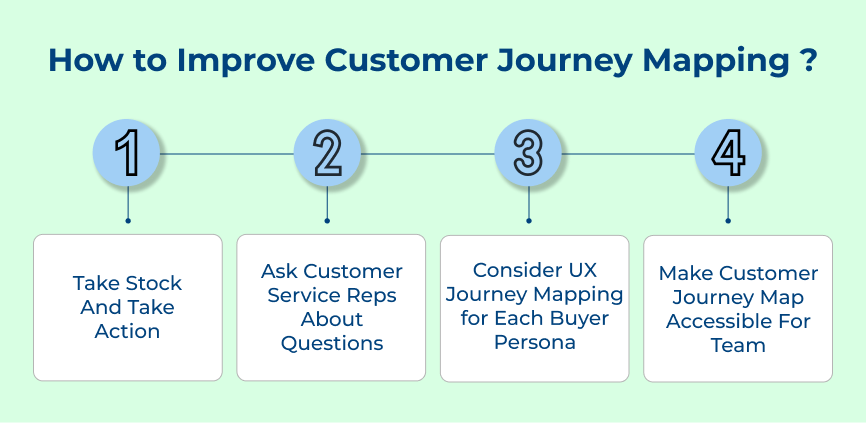
Before the brand can improve the consumer journey it needs to understand where it currently stands. Take stock of the current customer journey map and identify any gaps or pain points. Once the brand has a clear picture of the current state, take action to address any issues and make improvements.
The customer service team is on the front lines of customer interactions and can provide valuable insights into common customer questions. Asking the customer service reps about the questions they receive most frequently allows the brand to identify areas where its customer journey may be lacking. It helps to make necessary improvements.
The customers are not all the same, so it’s important to create specific customer journey maps for each of the buyer personas. Considering the unique preferences of each buyer persona allows the brand to create a more personalized and targeted customer journey that resonates with the customers.
Improving the customer journey is not just the responsibility of the marketing team. It’s important to make the customer journey map accessible to cross-functional teams such as sales, customer service and product development. Involving all relevant teams in the customer journey mapping process allows the brand to ensure that everyone is aligned and working towards a common goal.
Here are five examples of brands that have successfully focused on consumer journey mapping, along with how they prepared it and the impact it had on their business.
Apple is known for its seamless customer experience and this is largely attributed to their in-depth customer journey mapping. They meticulously track every touchpoint a customer has with their brand, from browsing their website to visiting a physical store. Understanding their customer’s journey allows Apple to tailor their marketing strategies and product offerings to meet their customer’s needs. It has led to increased customer satisfaction and loyalty.
Netflix is another brand that has excelled in customer journey mapping. They carefully analyze how customers interact with their platform, from signing up to searching for content to canceling their subscriptions. Understanding the pain points and preferences of customers allows Netflix to improve its user interface, recommend better content and reduce churn rates. It has resulted in a higher customer retention rate and increased revenue.
Nike is a brand that has successfully integrated customer journey mapping into their marketing strategy. They analyze how customers engage with their products, from browsing their website to making a purchase to receiving post-sales support. Mapping out these touchpoints allows Nike to create personalized marketing, improve online shopping experience and provide better customer service. It has led to increased brand loyalty and repeat purchases.
Airbnb is a brand that prioritizes customer journey mapping to ensure a smooth booking experience for their users. They analyze every step of the booking process, from searching for accommodations to leaving a review after the trip. Understanding customers’ journeys allows Airbnb to optimize its website or mobile app and offer personalized recommendations. It has resulted in increased customer satisfaction and higher booking rates.
Starbucks is a brand that has focused on customer journey mapping to enhance their in-store experience. They track every interaction a customer has with their brand, from ordering a coffee to collecting loyalty points to providing feedback. Analyzing these touchpoints allows Starbucks to create a more personalized and efficient customer experience. Leading to increased customer satisfaction and loyalty. It has helped Starbucks maintain its position as a leader in the coffee industry.
Investing in customer journey mapping templates can streamline the process and provide a structured framework for analyzing customer interactions. We’ll explore four common customer journey mapping templates that enhance understanding of the customer experience
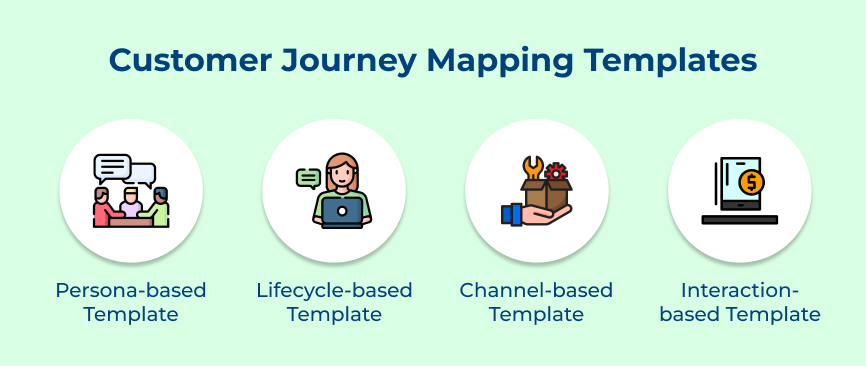
The template focuses on creating detailed personas of different customer segments and mapping out their journey from awareness to conversion. Each persona represents a specific type of customer with unique needs, preferences and behaviors.
The structure of this template includes:
The template focuses on mapping out the stages of the customer lifecycle, from initial contact to post-purchase engagement. The structure of this template includes:
The template focuses on mapping out the customer journey across different channels and touchpoints. The structure of this template includes:
The template focuses on mapping out the specific interactions that a customer has with the brand such as customer service calls, website visits and product purchases. The structure of this template includes:
Customer journey mapping is a powerful tool that can help businesses understand their customers better and improve their overall marketing strategy. Visually representing the customer’s interactions with the brand allows businesses to identify pain points, optimize touchpoints and ultimately enhance the customer’s journey.
Through thorough research, data analysis and strategic planning, businesses can map out success. Create a seamless and enjoyable customer experience that leads to increased customer satisfaction. Embrace journey mapping as a key component of the marketing strategy and watch the business thrive.
Customer journey maps are essential tools for businesses looking to improve customer experience. Visualizing the customer’s interactions with the brand at every touchpoint allows businesses to identify pain points and ultimately increase customer satisfaction. Using consumer journey maps helps businesses understand their customers better and tailor their strategies to meet their needs.
A journey map is essential for businesses to understand their customer’s experience through various touchpoints. It helps identify pain points, areas for improvement and opportunities for innovation. The brand should have a journey map when launching a new product, redesigning a website or aiming to enhance customer satisfaction. It guides strategic decision-making and improves overall customer experience.
A customer journey map typically includes the various touchpoints a customer has with a company before, during and after making a purchase. It outlines the customer’s thoughts, emotions and actions at each stage. Helping businesses understand their customers better and improve their overall experience. The map may also include pain points, opportunities for improvement and potential actions to take.
A touchpoint in a customer journey map is any interaction a customer has with a brand or product. These interactions can occur through various channels such as social media, email, website or in-person experiences. Understanding touchpoints is essential for businesses to effectively map out and enhance the customer experience throughout their journey with the brand.
Business must update the customer journey map regularly, at least every six months to a year, to ensure it remains accurate and relevant. Changes in customer behavior, market trends and business goals can impact the effectiveness of the map. Regularly updating it allows the brand to better meet the customers’ needs and improve their overall experience.

Market better, sell faster and support smarter with Veemo’s Conversation Customer Engagement suite of products.
Unify all your customer data in one platform to deliver contextual responses. Get a 360 degree view of the customer lifecycle without switching tools.
Connect with the tools you love to reduce manual activities and sync your business workflows for a seamless experience.
 https://veemo.io/wp-content/uploads/2024/12/customer-service-response-time.png
1256
2400
Webvision Solution
https://veemo.io/wp-content/uploads/2024/11/veemo.svg
Webvision Solution2025-10-17 10:51:142025-10-17 10:51:149 Effective Tips to Reduce Customer Service Response Time
https://veemo.io/wp-content/uploads/2024/12/customer-service-response-time.png
1256
2400
Webvision Solution
https://veemo.io/wp-content/uploads/2024/11/veemo.svg
Webvision Solution2025-10-17 10:51:142025-10-17 10:51:149 Effective Tips to Reduce Customer Service Response Time https://veemo.io/wp-content/uploads/2024/06/Customer-Communication-Best-Practices1.png
628
1200
Vikas Sachan
https://veemo.io/wp-content/uploads/2024/11/veemo.svg
Vikas Sachan2024-11-05 06:43:042024-11-05 06:43:04Top 15 Customer Communication Best Practices for Businesses
https://veemo.io/wp-content/uploads/2024/06/Customer-Communication-Best-Practices1.png
628
1200
Vikas Sachan
https://veemo.io/wp-content/uploads/2024/11/veemo.svg
Vikas Sachan2024-11-05 06:43:042024-11-05 06:43:04Top 15 Customer Communication Best Practices for Businesses https://veemo.io/wp-content/uploads/2024/02/Live-Chat-for-Sales.png
628
1200
teamwebvisionsolution@gmail.com
https://veemo.io/wp-content/uploads/2024/11/veemo.svg
teamwebvisionsolution@gmail.com2024-10-21 11:31:222025-08-06 10:22:06How to Use Live Chat for Sales? 7 Proven Ways to Grow Revenue
https://veemo.io/wp-content/uploads/2024/02/Live-Chat-for-Sales.png
628
1200
teamwebvisionsolution@gmail.com
https://veemo.io/wp-content/uploads/2024/11/veemo.svg
teamwebvisionsolution@gmail.com2024-10-21 11:31:222025-08-06 10:22:06How to Use Live Chat for Sales? 7 Proven Ways to Grow RevenueGrow Customer Relationships and stronger team collaboration with our range of products across the Conversational Engagement Suite.

 Differences Between Inbound and Outbound Customer Service
Scroll to top
Differences Between Inbound and Outbound Customer Service
Scroll to top